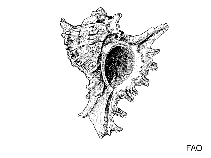Chorus giganteus (Lesson, 1831)
Top shell whelk| Native range | All suitable habitat | Point map | Year 2050 |

|
| This map was computer-generated and has not yet been reviewed. |
| Chorus giganteus AquaMaps Data sources: GBIF OBIS |
Google image | No image available for this species;
drawing shows typical species in Muricidae.
Classification / Names Common names | Synonyms | CoL | ITIS | WoRMS
Gastropoda | Neogastropoda | Muricidae
Environment: milieu / climate zone / depth range / distribution range Ecology
Benthic; depth range 5 - 20 m (Ref. 106787). Subtropical; 22°S - 44°S, 75°W - 70°W
Distribution Countries | FAO areas | Ecosystems | Occurrences | Introductions
Southeast Pacific: Endemic to Chile, from Valdivia to Antofagasta.
Length at first maturity / Size / Weight / Age
Maturity: Lm ? range ? - ? cm Max length : 13.0 cm TL male/unsexed; (Ref. 122474)
Life cycle and mating behavior Maturity | Reproduction | Spawning | Eggs | Fecundity | Larvae
Main reference
References | Coordinator | Collaborators
Servicio Nacional de Pesca y Acuicultura. 2011. (Ref. 90098)
IUCN Red List Status
(Ref. 130435: Version 2024-2)
CITES status (Ref. 108899)
CMS (Ref. 116361)
Threat to humans
Human uses
Fisheries: highly commercial
| FishSource |
Tools
More information
Max. ages / sizes
Length-weight rel.
Length-length rel.
Length-frequencies
Mass conversion
Abundance
Internet sources
BHL | BOLD Systems | CISTI | DiscoverLife | FAO(Publication : search) | Fishipedia | GenBank (genome, nucleotide) | GloBI | Gomexsi | Google Books | Google Scholar | Google | PubMed | Tree of Life | Wikipedia (Go, Search) | Zoological Record



